HRM Short Answer Assessments
VerifiedAdded on 2019/09/16
|32
|11393
|417
Homework Assignment
AI Summary
This document outlines two short answer assessment tasks related to Human Resource Management (HRM) practices within the context of a case study involving an organization called CERA. The first task focuses on selection methods and minority representation, requiring students to discuss problematic selection methods for increasing Aboriginal representation in CERA's workforce. The second task addresses CERA's bonus scheme, asking students to suggest improvements, justify them with literature, and consider whether the scheme should be scrapped. The document also includes extensive background information on CERA's HR practices, diversity management, recruitment and selection, performance management, and reward systems, along with various learning activities and readings to support students in completing the assessments. Students are required to use a minimum of five sources, including academic ones, and follow APA 6 referencing style.
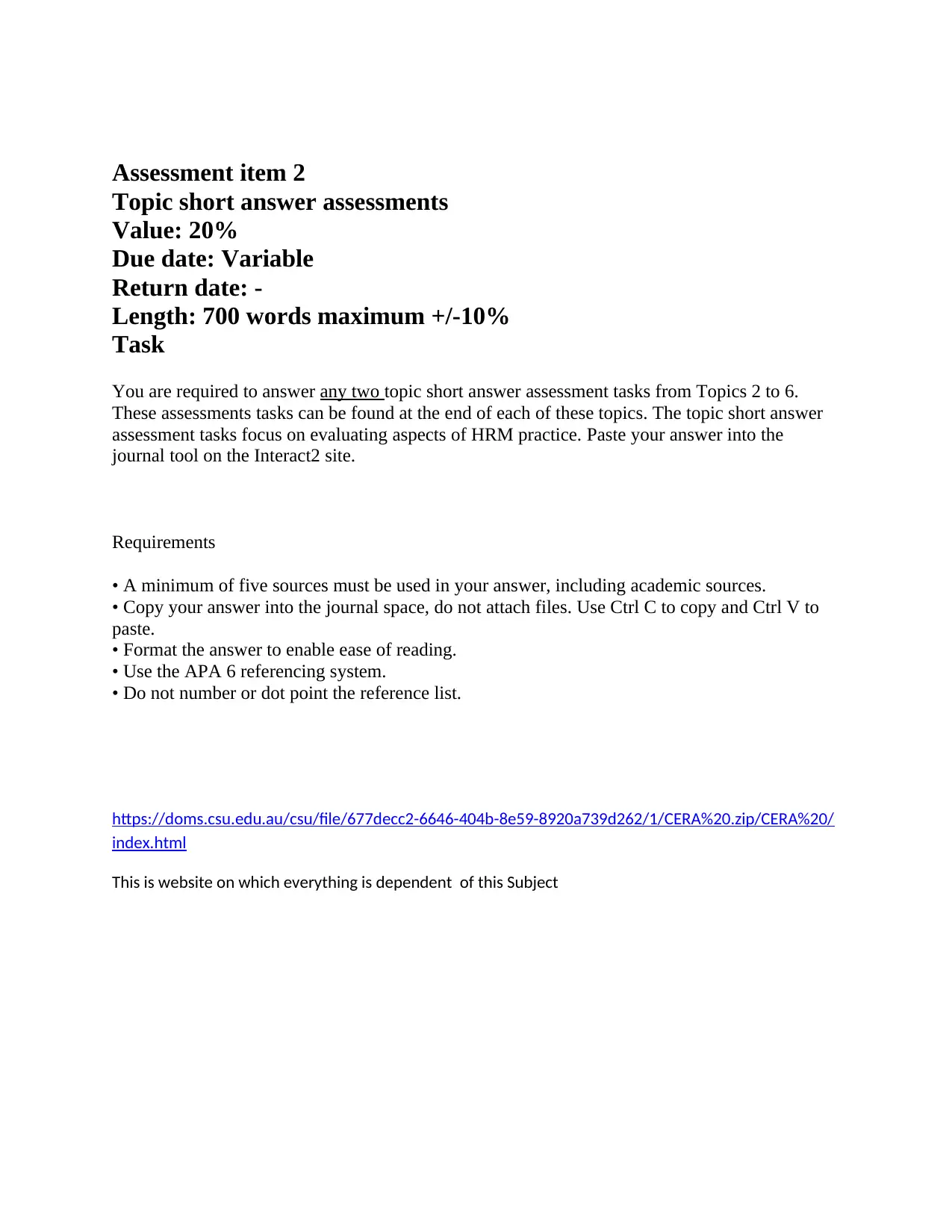
Assessment item 2
Topic short answer assessments
Value: 20%
Due date: Variable
Return date: -
Length: 700 words maximum +/-10%
Task
You are required to answer any two topic short answer assessment tasks from Topics 2 to 6.
These assessments tasks can be found at the end of each of these topics. The topic short answer
assessment tasks focus on evaluating aspects of HRM practice. Paste your answer into the
journal tool on the Interact2 site.
Requirements
• A minimum of five sources must be used in your answer, including academic sources.
• Copy your answer into the journal space, do not attach files. Use Ctrl C to copy and Ctrl V to
paste.
• Format the answer to enable ease of reading.
• Use the APA 6 referencing system.
• Do not number or dot point the reference list.
https://doms.csu.edu.au/csu/file/677decc2-6646-404b-8e59-8920a739d262/1/CERA%20.zip/CERA%20/
index.html
This is website on which everything is dependent of this Subject
Topic short answer assessments
Value: 20%
Due date: Variable
Return date: -
Length: 700 words maximum +/-10%
Task
You are required to answer any two topic short answer assessment tasks from Topics 2 to 6.
These assessments tasks can be found at the end of each of these topics. The topic short answer
assessment tasks focus on evaluating aspects of HRM practice. Paste your answer into the
journal tool on the Interact2 site.
Requirements
• A minimum of five sources must be used in your answer, including academic sources.
• Copy your answer into the journal space, do not attach files. Use Ctrl C to copy and Ctrl V to
paste.
• Format the answer to enable ease of reading.
• Use the APA 6 referencing system.
• Do not number or dot point the reference list.
https://doms.csu.edu.au/csu/file/677decc2-6646-404b-8e59-8920a739d262/1/CERA%20.zip/CERA%20/
index.html
This is website on which everything is dependent of this Subject
Paraphrase This Document
Need a fresh take? Get an instant paraphrase of this document with our AI Paraphraser
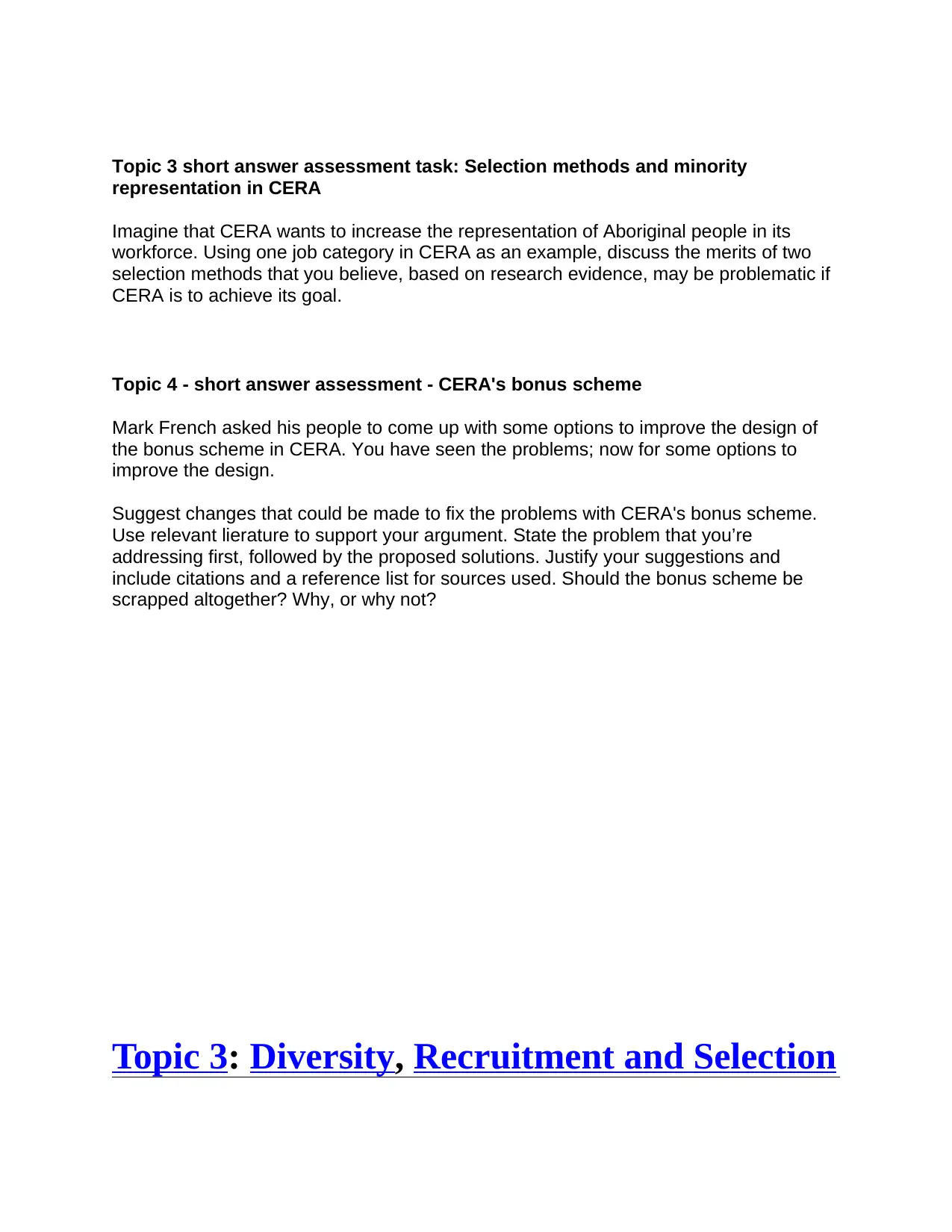
Topic 3 short answer assessment task: Selection methods and minority
representation in CERA
Imagine that CERA wants to increase the representation of Aboriginal people in its
workforce. Using one job category in CERA as an example, discuss the merits of two
selection methods that you believe, based on research evidence, may be problematic if
CERA is to achieve its goal.
Topic 4 - short answer assessment - CERA's bonus scheme
Mark French asked his people to come up with some options to improve the design of
the bonus scheme in CERA. You have seen the problems; now for some options to
improve the design.
Suggest changes that could be made to fix the problems with CERA's bonus scheme.
Use relevant lierature to support your argument. State the problem that you’re
addressing first, followed by the proposed solutions. Justify your suggestions and
include citations and a reference list for sources used. Should the bonus scheme be
scrapped altogether? Why, or why not?
Topic 3: Diversity, Recruitment and Selection
representation in CERA
Imagine that CERA wants to increase the representation of Aboriginal people in its
workforce. Using one job category in CERA as an example, discuss the merits of two
selection methods that you believe, based on research evidence, may be problematic if
CERA is to achieve its goal.
Topic 4 - short answer assessment - CERA's bonus scheme
Mark French asked his people to come up with some options to improve the design of
the bonus scheme in CERA. You have seen the problems; now for some options to
improve the design.
Suggest changes that could be made to fix the problems with CERA's bonus scheme.
Use relevant lierature to support your argument. State the problem that you’re
addressing first, followed by the proposed solutions. Justify your suggestions and
include citations and a reference list for sources used. Should the bonus scheme be
scrapped altogether? Why, or why not?
Topic 3: Diversity, Recruitment and Selection
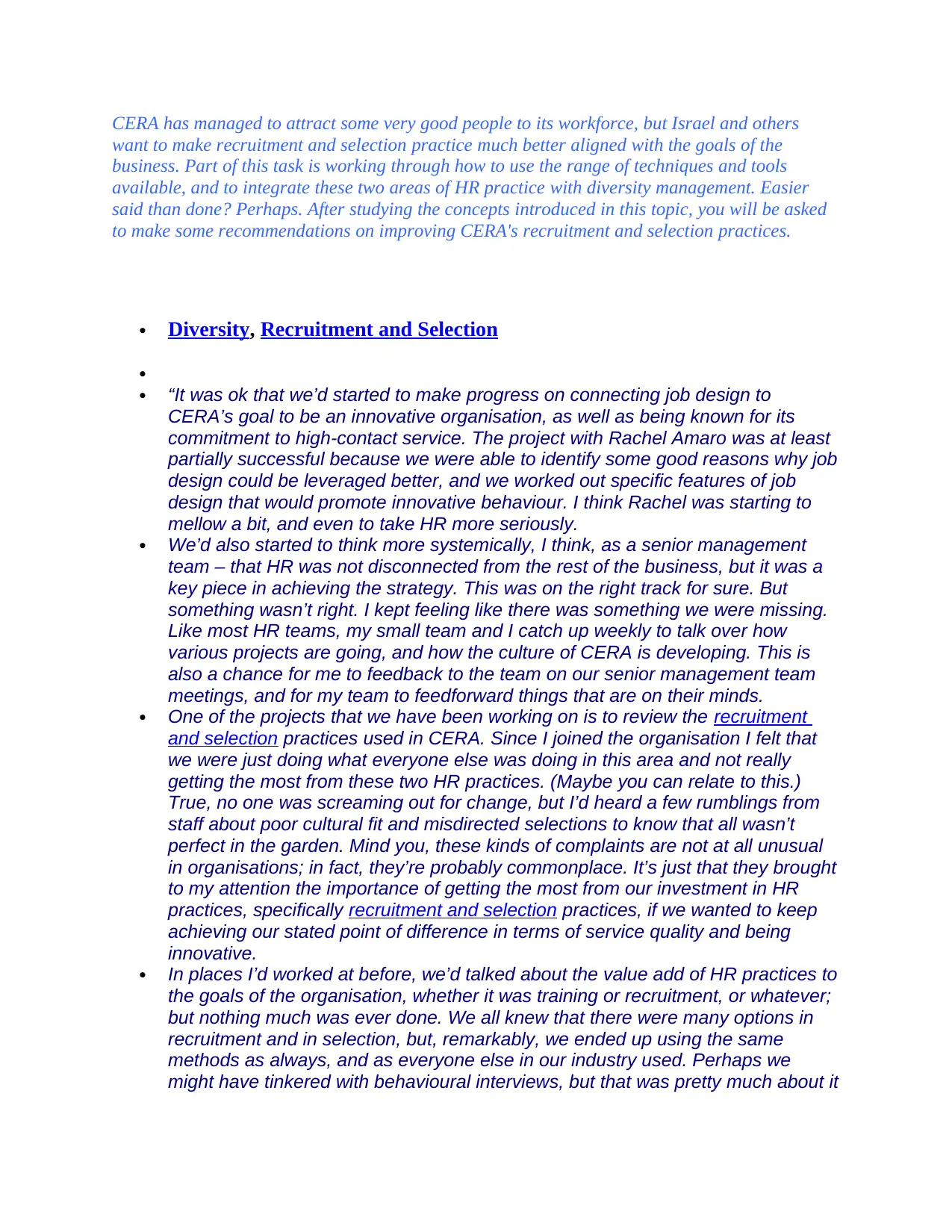
CERA has managed to attract some very good people to its workforce, but Israel and others
want to make recruitment and selection practice much better aligned with the goals of the
business. Part of this task is working through how to use the range of techniques and tools
available, and to integrate these two areas of HR practice with diversity management. Easier
said than done? Perhaps. After studying the concepts introduced in this topic, you will be asked
to make some recommendations on improving CERA's recruitment and selection practices.
Diversity, Recruitment and Selection
“It was ok that we’d started to make progress on connecting job design to
CERA’s goal to be an innovative organisation, as well as being known for its
commitment to high-contact service. The project with Rachel Amaro was at least
partially successful because we were able to identify some good reasons why job
design could be leveraged better, and we worked out specific features of job
design that would promote innovative behaviour. I think Rachel was starting to
mellow a bit, and even to take HR more seriously.
We’d also started to think more systemically, I think, as a senior management
team – that HR was not disconnected from the rest of the business, but it was a
key piece in achieving the strategy. This was on the right track for sure. But
something wasn’t right. I kept feeling like there was something we were missing.
Like most HR teams, my small team and I catch up weekly to talk over how
various projects are going, and how the culture of CERA is developing. This is
also a chance for me to feedback to the team on our senior management team
meetings, and for my team to feedforward things that are on their minds.
One of the projects that we have been working on is to review the recruitment
and selection practices used in CERA. Since I joined the organisation I felt that
we were just doing what everyone else was doing in this area and not really
getting the most from these two HR practices. (Maybe you can relate to this.)
True, no one was screaming out for change, but I’d heard a few rumblings from
staff about poor cultural fit and misdirected selections to know that all wasn’t
perfect in the garden. Mind you, these kinds of complaints are not at all unusual
in organisations; in fact, they’re probably commonplace. It’s just that they brought
to my attention the importance of getting the most from our investment in HR
practices, specifically recruitment and selection practices, if we wanted to keep
achieving our stated point of difference in terms of service quality and being
innovative.
In places I’d worked at before, we’d talked about the value add of HR practices to
the goals of the organisation, whether it was training or recruitment, or whatever;
but nothing much was ever done. We all knew that there were many options in
recruitment and in selection, but, remarkably, we ended up using the same
methods as always, and as everyone else in our industry used. Perhaps we
might have tinkered with behavioural interviews, but that was pretty much about it
want to make recruitment and selection practice much better aligned with the goals of the
business. Part of this task is working through how to use the range of techniques and tools
available, and to integrate these two areas of HR practice with diversity management. Easier
said than done? Perhaps. After studying the concepts introduced in this topic, you will be asked
to make some recommendations on improving CERA's recruitment and selection practices.
Diversity, Recruitment and Selection
“It was ok that we’d started to make progress on connecting job design to
CERA’s goal to be an innovative organisation, as well as being known for its
commitment to high-contact service. The project with Rachel Amaro was at least
partially successful because we were able to identify some good reasons why job
design could be leveraged better, and we worked out specific features of job
design that would promote innovative behaviour. I think Rachel was starting to
mellow a bit, and even to take HR more seriously.
We’d also started to think more systemically, I think, as a senior management
team – that HR was not disconnected from the rest of the business, but it was a
key piece in achieving the strategy. This was on the right track for sure. But
something wasn’t right. I kept feeling like there was something we were missing.
Like most HR teams, my small team and I catch up weekly to talk over how
various projects are going, and how the culture of CERA is developing. This is
also a chance for me to feedback to the team on our senior management team
meetings, and for my team to feedforward things that are on their minds.
One of the projects that we have been working on is to review the recruitment
and selection practices used in CERA. Since I joined the organisation I felt that
we were just doing what everyone else was doing in this area and not really
getting the most from these two HR practices. (Maybe you can relate to this.)
True, no one was screaming out for change, but I’d heard a few rumblings from
staff about poor cultural fit and misdirected selections to know that all wasn’t
perfect in the garden. Mind you, these kinds of complaints are not at all unusual
in organisations; in fact, they’re probably commonplace. It’s just that they brought
to my attention the importance of getting the most from our investment in HR
practices, specifically recruitment and selection practices, if we wanted to keep
achieving our stated point of difference in terms of service quality and being
innovative.
In places I’d worked at before, we’d talked about the value add of HR practices to
the goals of the organisation, whether it was training or recruitment, or whatever;
but nothing much was ever done. We all knew that there were many options in
recruitment and in selection, but, remarkably, we ended up using the same
methods as always, and as everyone else in our industry used. Perhaps we
might have tinkered with behavioural interviews, but that was pretty much about it
⊘ This is a preview!⊘
Do you want full access?
Subscribe today to unlock all pages.

Trusted by 1+ million students worldwide
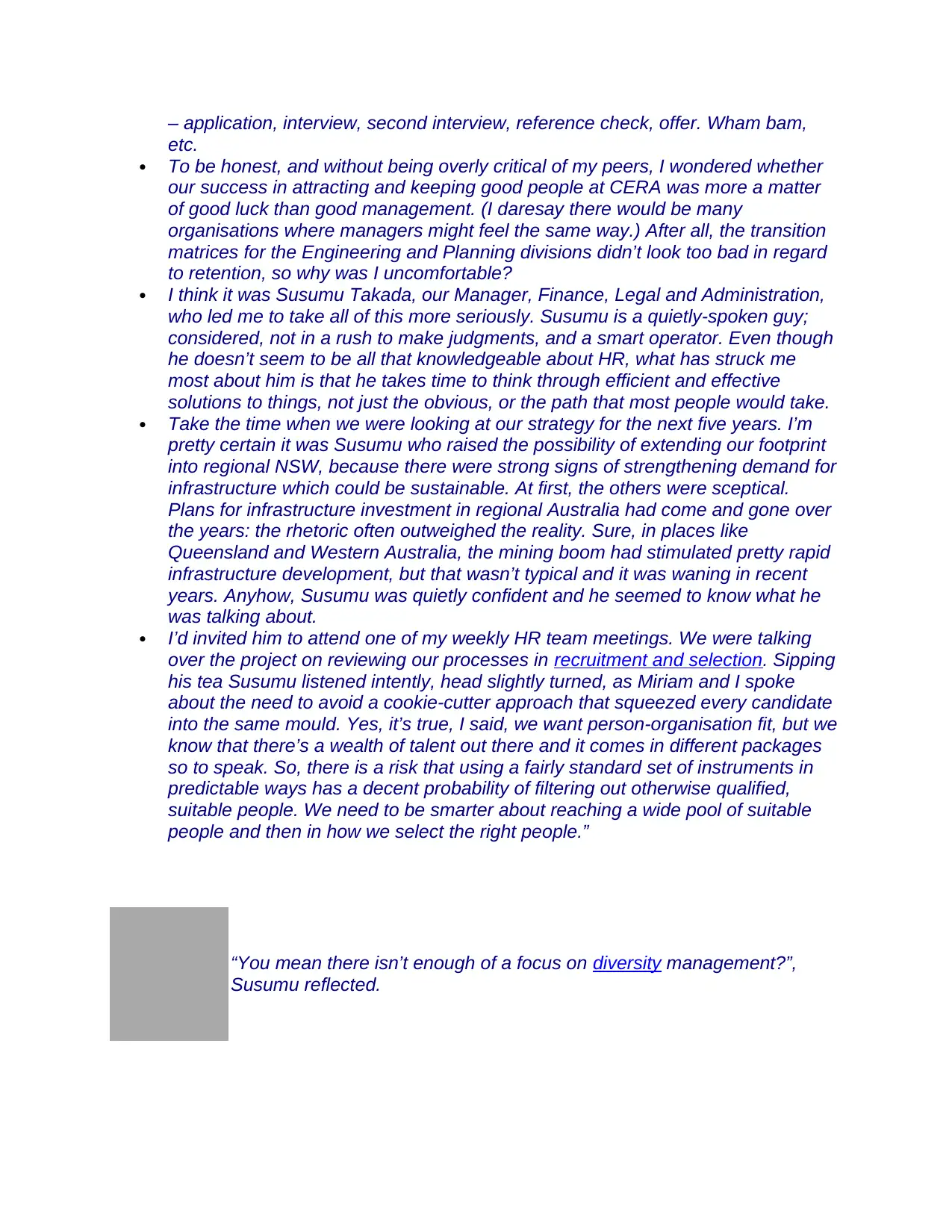
– application, interview, second interview, reference check, offer. Wham bam,
etc.
To be honest, and without being overly critical of my peers, I wondered whether
our success in attracting and keeping good people at CERA was more a matter
of good luck than good management. (I daresay there would be many
organisations where managers might feel the same way.) After all, the transition
matrices for the Engineering and Planning divisions didn’t look too bad in regard
to retention, so why was I uncomfortable?
I think it was Susumu Takada, our Manager, Finance, Legal and Administration,
who led me to take all of this more seriously. Susumu is a quietly-spoken guy;
considered, not in a rush to make judgments, and a smart operator. Even though
he doesn’t seem to be all that knowledgeable about HR, what has struck me
most about him is that he takes time to think through efficient and effective
solutions to things, not just the obvious, or the path that most people would take.
Take the time when we were looking at our strategy for the next five years. I’m
pretty certain it was Susumu who raised the possibility of extending our footprint
into regional NSW, because there were strong signs of strengthening demand for
infrastructure which could be sustainable. At first, the others were sceptical.
Plans for infrastructure investment in regional Australia had come and gone over
the years: the rhetoric often outweighed the reality. Sure, in places like
Queensland and Western Australia, the mining boom had stimulated pretty rapid
infrastructure development, but that wasn’t typical and it was waning in recent
years. Anyhow, Susumu was quietly confident and he seemed to know what he
was talking about.
I’d invited him to attend one of my weekly HR team meetings. We were talking
over the project on reviewing our processes in recruitment and selection. Sipping
his tea Susumu listened intently, head slightly turned, as Miriam and I spoke
about the need to avoid a cookie-cutter approach that squeezed every candidate
into the same mould. Yes, it’s true, I said, we want person-organisation fit, but we
know that there’s a wealth of talent out there and it comes in different packages
so to speak. So, there is a risk that using a fairly standard set of instruments in
predictable ways has a decent probability of filtering out otherwise qualified,
suitable people. We need to be smarter about reaching a wide pool of suitable
people and then in how we select the right people.”
“You mean there isn’t enough of a focus on diversity management?”,
Susumu reflected.
etc.
To be honest, and without being overly critical of my peers, I wondered whether
our success in attracting and keeping good people at CERA was more a matter
of good luck than good management. (I daresay there would be many
organisations where managers might feel the same way.) After all, the transition
matrices for the Engineering and Planning divisions didn’t look too bad in regard
to retention, so why was I uncomfortable?
I think it was Susumu Takada, our Manager, Finance, Legal and Administration,
who led me to take all of this more seriously. Susumu is a quietly-spoken guy;
considered, not in a rush to make judgments, and a smart operator. Even though
he doesn’t seem to be all that knowledgeable about HR, what has struck me
most about him is that he takes time to think through efficient and effective
solutions to things, not just the obvious, or the path that most people would take.
Take the time when we were looking at our strategy for the next five years. I’m
pretty certain it was Susumu who raised the possibility of extending our footprint
into regional NSW, because there were strong signs of strengthening demand for
infrastructure which could be sustainable. At first, the others were sceptical.
Plans for infrastructure investment in regional Australia had come and gone over
the years: the rhetoric often outweighed the reality. Sure, in places like
Queensland and Western Australia, the mining boom had stimulated pretty rapid
infrastructure development, but that wasn’t typical and it was waning in recent
years. Anyhow, Susumu was quietly confident and he seemed to know what he
was talking about.
I’d invited him to attend one of my weekly HR team meetings. We were talking
over the project on reviewing our processes in recruitment and selection. Sipping
his tea Susumu listened intently, head slightly turned, as Miriam and I spoke
about the need to avoid a cookie-cutter approach that squeezed every candidate
into the same mould. Yes, it’s true, I said, we want person-organisation fit, but we
know that there’s a wealth of talent out there and it comes in different packages
so to speak. So, there is a risk that using a fairly standard set of instruments in
predictable ways has a decent probability of filtering out otherwise qualified,
suitable people. We need to be smarter about reaching a wide pool of suitable
people and then in how we select the right people.”
“You mean there isn’t enough of a focus on diversity management?”,
Susumu reflected.
Paraphrase This Document
Need a fresh take? Get an instant paraphrase of this document with our AI Paraphraser
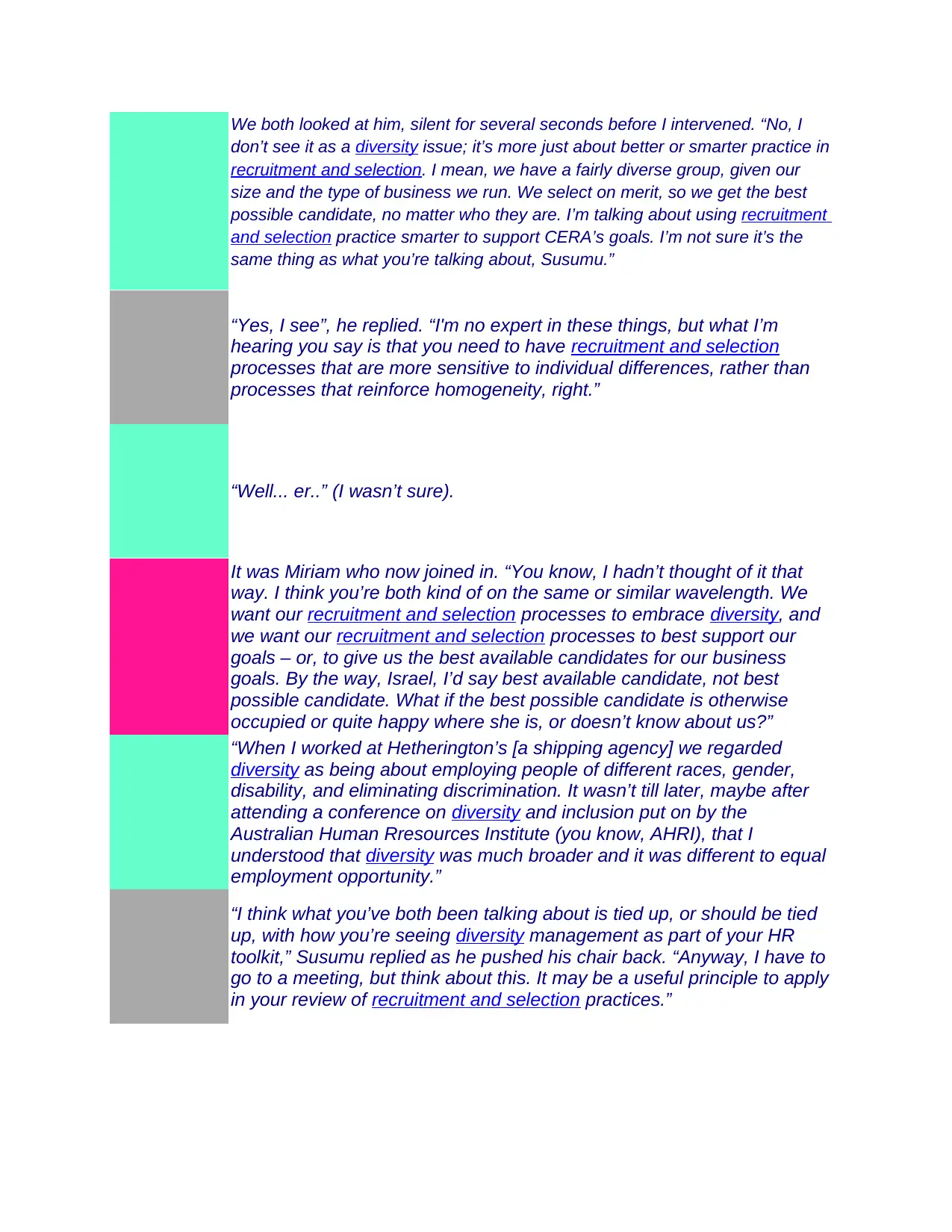
We both looked at him, silent for several seconds before I intervened. “No, I
don’t see it as a diversity issue; it’s more just about better or smarter practice in
recruitment and selection. I mean, we have a fairly diverse group, given our
size and the type of business we run. We select on merit, so we get the best
possible candidate, no matter who they are. I’m talking about using recruitment
and selection practice smarter to support CERA’s goals. I’m not sure it’s the
same thing as what you’re talking about, Susumu.”
“Yes, I see”, he replied. “I'm no expert in these things, but what I’m
hearing you say is that you need to have recruitment and selection
processes that are more sensitive to individual differences, rather than
processes that reinforce homogeneity, right.”
“Well... er..” (I wasn’t sure).
It was Miriam who now joined in. “You know, I hadn’t thought of it that
way. I think you’re both kind of on the same or similar wavelength. We
want our recruitment and selection processes to embrace diversity, and
we want our recruitment and selection processes to best support our
goals – or, to give us the best available candidates for our business
goals. By the way, Israel, I’d say best available candidate, not best
possible candidate. What if the best possible candidate is otherwise
occupied or quite happy where she is, or doesn’t know about us?”
“When I worked at Hetherington’s [a shipping agency] we regarded
diversity as being about employing people of different races, gender,
disability, and eliminating discrimination. It wasn’t till later, maybe after
attending a conference on diversity and inclusion put on by the
Australian Human Rresources Institute (you know, AHRI), that I
understood that diversity was much broader and it was different to equal
employment opportunity.”
“I think what you’ve both been talking about is tied up, or should be tied
up, with how you’re seeing diversity management as part of your HR
toolkit,” Susumu replied as he pushed his chair back. “Anyway, I have to
go to a meeting, but think about this. It may be a useful principle to apply
in your review of recruitment and selection practices.”
don’t see it as a diversity issue; it’s more just about better or smarter practice in
recruitment and selection. I mean, we have a fairly diverse group, given our
size and the type of business we run. We select on merit, so we get the best
possible candidate, no matter who they are. I’m talking about using recruitment
and selection practice smarter to support CERA’s goals. I’m not sure it’s the
same thing as what you’re talking about, Susumu.”
“Yes, I see”, he replied. “I'm no expert in these things, but what I’m
hearing you say is that you need to have recruitment and selection
processes that are more sensitive to individual differences, rather than
processes that reinforce homogeneity, right.”
“Well... er..” (I wasn’t sure).
It was Miriam who now joined in. “You know, I hadn’t thought of it that
way. I think you’re both kind of on the same or similar wavelength. We
want our recruitment and selection processes to embrace diversity, and
we want our recruitment and selection processes to best support our
goals – or, to give us the best available candidates for our business
goals. By the way, Israel, I’d say best available candidate, not best
possible candidate. What if the best possible candidate is otherwise
occupied or quite happy where she is, or doesn’t know about us?”
“When I worked at Hetherington’s [a shipping agency] we regarded
diversity as being about employing people of different races, gender,
disability, and eliminating discrimination. It wasn’t till later, maybe after
attending a conference on diversity and inclusion put on by the
Australian Human Rresources Institute (you know, AHRI), that I
understood that diversity was much broader and it was different to equal
employment opportunity.”
“I think what you’ve both been talking about is tied up, or should be tied
up, with how you’re seeing diversity management as part of your HR
toolkit,” Susumu replied as he pushed his chair back. “Anyway, I have to
go to a meeting, but think about this. It may be a useful principle to apply
in your review of recruitment and selection practices.”
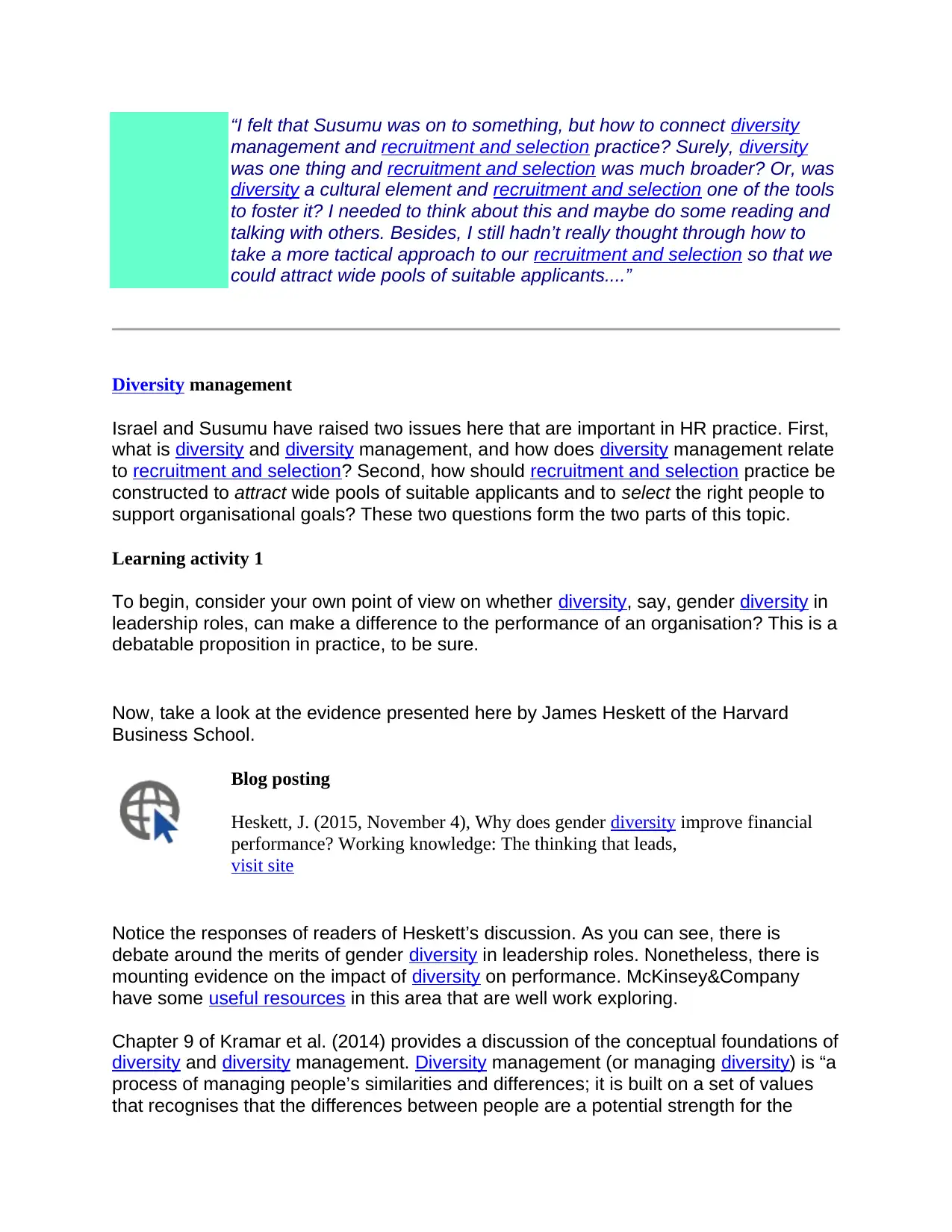
“I felt that Susumu was on to something, but how to connect diversity
management and recruitment and selection practice? Surely, diversity
was one thing and recruitment and selection was much broader? Or, was
diversity a cultural element and recruitment and selection one of the tools
to foster it? I needed to think about this and maybe do some reading and
talking with others. Besides, I still hadn’t really thought through how to
take a more tactical approach to our recruitment and selection so that we
could attract wide pools of suitable applicants....”
Diversity management
Israel and Susumu have raised two issues here that are important in HR practice. First,
what is diversity and diversity management, and how does diversity management relate
to recruitment and selection? Second, how should recruitment and selection practice be
constructed to attract wide pools of suitable applicants and to select the right people to
support organisational goals? These two questions form the two parts of this topic.
Learning activity 1
To begin, consider your own point of view on whether diversity, say, gender diversity in
leadership roles, can make a difference to the performance of an organisation? This is a
debatable proposition in practice, to be sure.
Now, take a look at the evidence presented here by James Heskett of the Harvard
Business School.
Blog posting
Heskett, J. (2015, November 4), Why does gender diversity improve financial
performance? Working knowledge: The thinking that leads,
visit site
Notice the responses of readers of Heskett’s discussion. As you can see, there is
debate around the merits of gender diversity in leadership roles. Nonetheless, there is
mounting evidence on the impact of diversity on performance. McKinsey&Company
have some useful resources in this area that are well work exploring.
Chapter 9 of Kramar et al. (2014) provides a discussion of the conceptual foundations of
diversity and diversity management. Diversity management (or managing diversity) is “a
process of managing people’s similarities and differences; it is built on a set of values
that recognises that the differences between people are a potential strength for the
management and recruitment and selection practice? Surely, diversity
was one thing and recruitment and selection was much broader? Or, was
diversity a cultural element and recruitment and selection one of the tools
to foster it? I needed to think about this and maybe do some reading and
talking with others. Besides, I still hadn’t really thought through how to
take a more tactical approach to our recruitment and selection so that we
could attract wide pools of suitable applicants....”
Diversity management
Israel and Susumu have raised two issues here that are important in HR practice. First,
what is diversity and diversity management, and how does diversity management relate
to recruitment and selection? Second, how should recruitment and selection practice be
constructed to attract wide pools of suitable applicants and to select the right people to
support organisational goals? These two questions form the two parts of this topic.
Learning activity 1
To begin, consider your own point of view on whether diversity, say, gender diversity in
leadership roles, can make a difference to the performance of an organisation? This is a
debatable proposition in practice, to be sure.
Now, take a look at the evidence presented here by James Heskett of the Harvard
Business School.
Blog posting
Heskett, J. (2015, November 4), Why does gender diversity improve financial
performance? Working knowledge: The thinking that leads,
visit site
Notice the responses of readers of Heskett’s discussion. As you can see, there is
debate around the merits of gender diversity in leadership roles. Nonetheless, there is
mounting evidence on the impact of diversity on performance. McKinsey&Company
have some useful resources in this area that are well work exploring.
Chapter 9 of Kramar et al. (2014) provides a discussion of the conceptual foundations of
diversity and diversity management. Diversity management (or managing diversity) is “a
process of managing people’s similarities and differences; it is built on a set of values
that recognises that the differences between people are a potential strength for the
⊘ This is a preview!⊘
Do you want full access?
Subscribe today to unlock all pages.

Trusted by 1+ million students worldwide
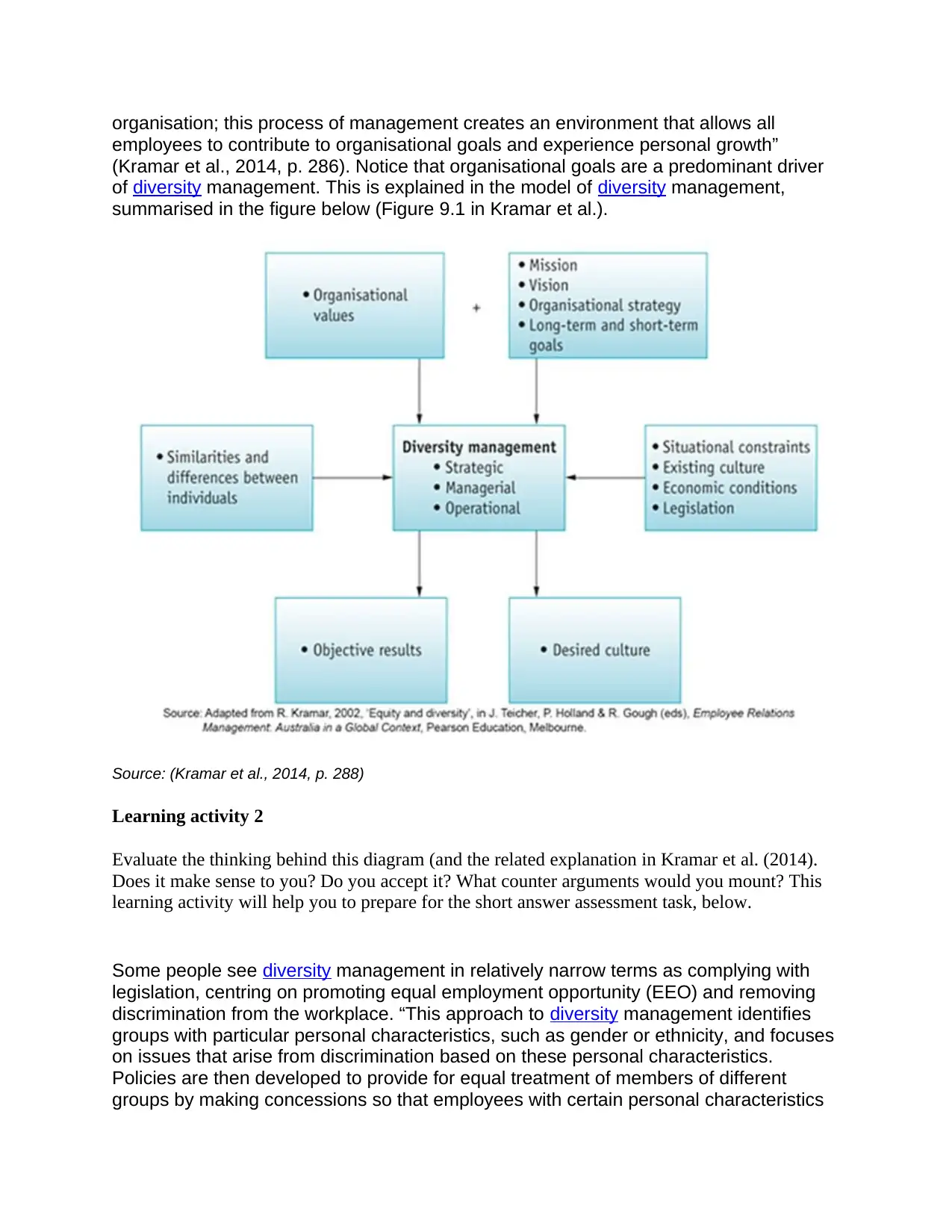
organisation; this process of management creates an environment that allows all
employees to contribute to organisational goals and experience personal growth”
(Kramar et al., 2014, p. 286). Notice that organisational goals are a predominant driver
of diversity management. This is explained in the model of diversity management,
summarised in the figure below (Figure 9.1 in Kramar et al.).
Source: (Kramar et al., 2014, p. 288)
Learning activity 2
Evaluate the thinking behind this diagram (and the related explanation in Kramar et al. (2014).
Does it make sense to you? Do you accept it? What counter arguments would you mount? This
learning activity will help you to prepare for the short answer assessment task, below.
Some people see diversity management in relatively narrow terms as complying with
legislation, centring on promoting equal employment opportunity (EEO) and removing
discrimination from the workplace. “This approach to diversity management identifies
groups with particular personal characteristics, such as gender or ethnicity, and focuses
on issues that arise from discrimination based on these personal characteristics.
Policies are then developed to provide for equal treatment of members of different
groups by making concessions so that employees with certain personal characteristics
employees to contribute to organisational goals and experience personal growth”
(Kramar et al., 2014, p. 286). Notice that organisational goals are a predominant driver
of diversity management. This is explained in the model of diversity management,
summarised in the figure below (Figure 9.1 in Kramar et al.).
Source: (Kramar et al., 2014, p. 288)
Learning activity 2
Evaluate the thinking behind this diagram (and the related explanation in Kramar et al. (2014).
Does it make sense to you? Do you accept it? What counter arguments would you mount? This
learning activity will help you to prepare for the short answer assessment task, below.
Some people see diversity management in relatively narrow terms as complying with
legislation, centring on promoting equal employment opportunity (EEO) and removing
discrimination from the workplace. “This approach to diversity management identifies
groups with particular personal characteristics, such as gender or ethnicity, and focuses
on issues that arise from discrimination based on these personal characteristics.
Policies are then developed to provide for equal treatment of members of different
groups by making concessions so that employees with certain personal characteristics
Paraphrase This Document
Need a fresh take? Get an instant paraphrase of this document with our AI Paraphraser
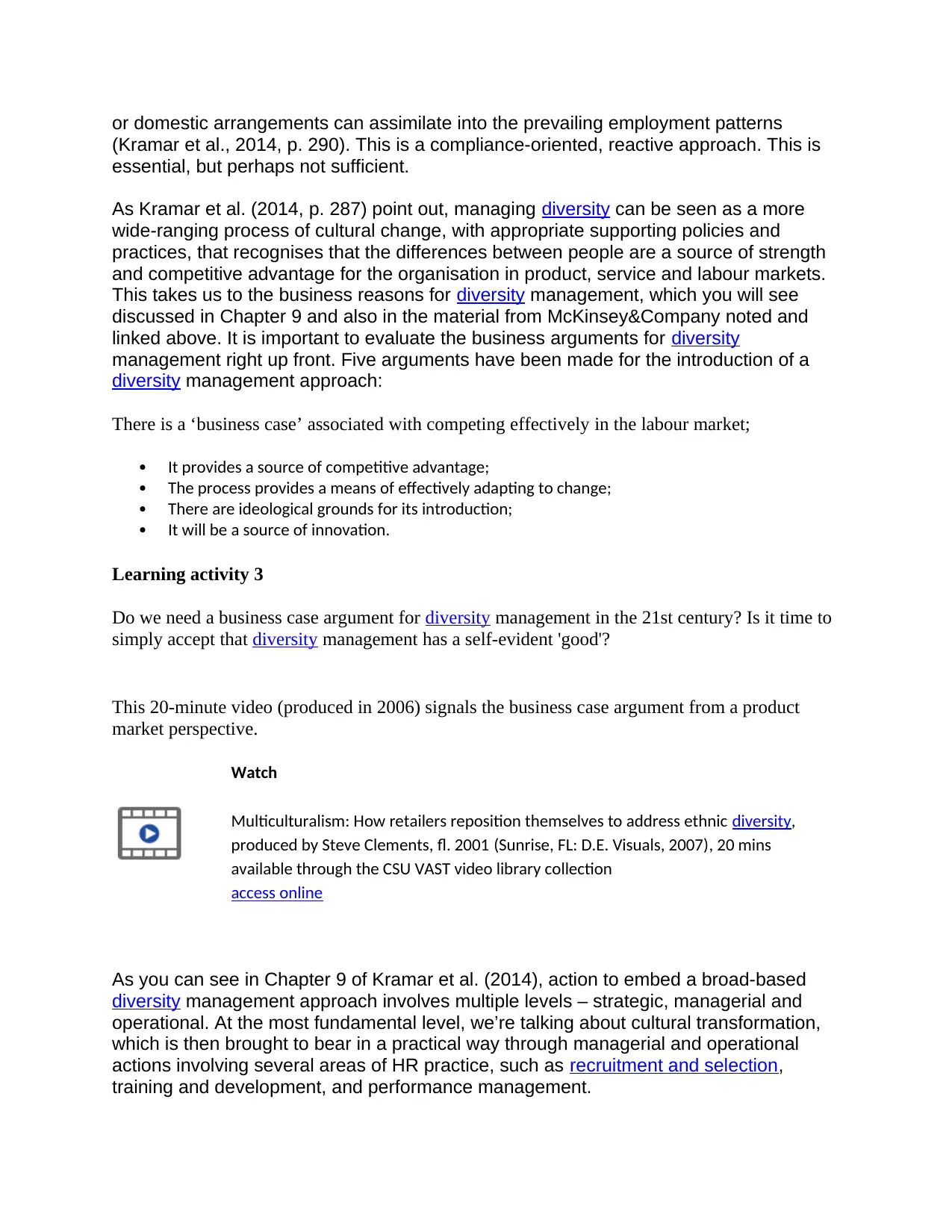
or domestic arrangements can assimilate into the prevailing employment patterns
(Kramar et al., 2014, p. 290). This is a compliance-oriented, reactive approach. This is
essential, but perhaps not sufficient.
As Kramar et al. (2014, p. 287) point out, managing diversity can be seen as a more
wide-ranging process of cultural change, with appropriate supporting policies and
practices, that recognises that the differences between people are a source of strength
and competitive advantage for the organisation in product, service and labour markets.
This takes us to the business reasons for diversity management, which you will see
discussed in Chapter 9 and also in the material from McKinsey&Company noted and
linked above. It is important to evaluate the business arguments for diversity
management right up front. Five arguments have been made for the introduction of a
diversity management approach:
There is a ‘business case’ associated with competing effectively in the labour market;
It provides a source of competitive advantage;
The process provides a means of effectively adapting to change;
There are ideological grounds for its introduction;
It will be a source of innovation.
Learning activity 3
Do we need a business case argument for diversity management in the 21st century? Is it time to
simply accept that diversity management has a self-evident 'good'?
This 20-minute video (produced in 2006) signals the business case argument from a product
market perspective.
Watch
Multiculturalism: How retailers reposition themselves to address ethnic diversity,
produced by Steve Clements, fl. 2001 (Sunrise, FL: D.E. Visuals, 2007), 20 mins
available through the CSU VAST video library collection
access online
As you can see in Chapter 9 of Kramar et al. (2014), action to embed a broad-based
diversity management approach involves multiple levels – strategic, managerial and
operational. At the most fundamental level, we’re talking about cultural transformation,
which is then brought to bear in a practical way through managerial and operational
actions involving several areas of HR practice, such as recruitment and selection,
training and development, and performance management.
(Kramar et al., 2014, p. 290). This is a compliance-oriented, reactive approach. This is
essential, but perhaps not sufficient.
As Kramar et al. (2014, p. 287) point out, managing diversity can be seen as a more
wide-ranging process of cultural change, with appropriate supporting policies and
practices, that recognises that the differences between people are a source of strength
and competitive advantage for the organisation in product, service and labour markets.
This takes us to the business reasons for diversity management, which you will see
discussed in Chapter 9 and also in the material from McKinsey&Company noted and
linked above. It is important to evaluate the business arguments for diversity
management right up front. Five arguments have been made for the introduction of a
diversity management approach:
There is a ‘business case’ associated with competing effectively in the labour market;
It provides a source of competitive advantage;
The process provides a means of effectively adapting to change;
There are ideological grounds for its introduction;
It will be a source of innovation.
Learning activity 3
Do we need a business case argument for diversity management in the 21st century? Is it time to
simply accept that diversity management has a self-evident 'good'?
This 20-minute video (produced in 2006) signals the business case argument from a product
market perspective.
Watch
Multiculturalism: How retailers reposition themselves to address ethnic diversity,
produced by Steve Clements, fl. 2001 (Sunrise, FL: D.E. Visuals, 2007), 20 mins
available through the CSU VAST video library collection
access online
As you can see in Chapter 9 of Kramar et al. (2014), action to embed a broad-based
diversity management approach involves multiple levels – strategic, managerial and
operational. At the most fundamental level, we’re talking about cultural transformation,
which is then brought to bear in a practical way through managerial and operational
actions involving several areas of HR practice, such as recruitment and selection,
training and development, and performance management.
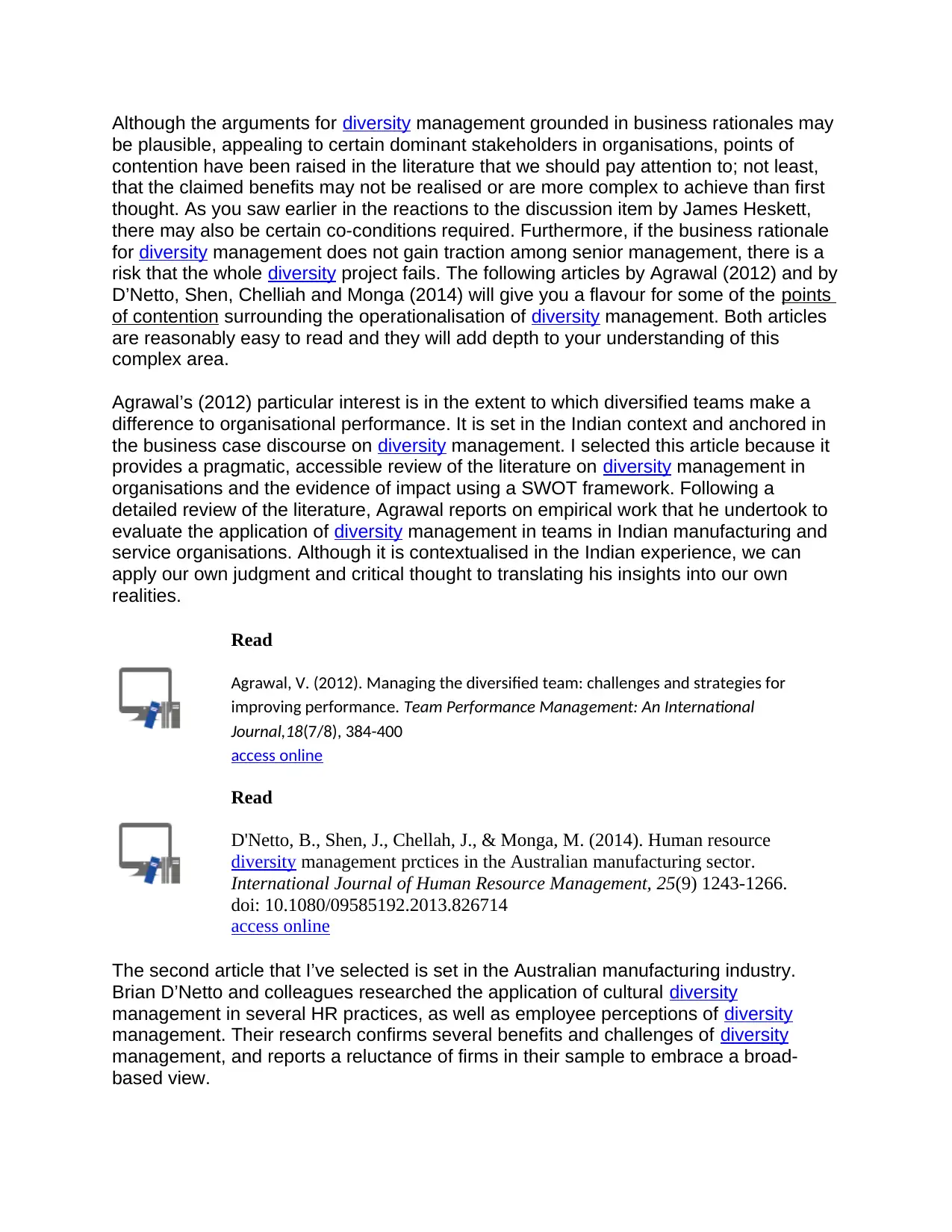
Although the arguments for diversity management grounded in business rationales may
be plausible, appealing to certain dominant stakeholders in organisations, points of
contention have been raised in the literature that we should pay attention to; not least,
that the claimed benefits may not be realised or are more complex to achieve than first
thought. As you saw earlier in the reactions to the discussion item by James Heskett,
there may also be certain co-conditions required. Furthermore, if the business rationale
for diversity management does not gain traction among senior management, there is a
risk that the whole diversity project fails. The following articles by Agrawal (2012) and by
D’Netto, Shen, Chelliah and Monga (2014) will give you a flavour for some of the points
of contention surrounding the operationalisation of diversity management. Both articles
are reasonably easy to read and they will add depth to your understanding of this
complex area.
Agrawal’s (2012) particular interest is in the extent to which diversified teams make a
difference to organisational performance. It is set in the Indian context and anchored in
the business case discourse on diversity management. I selected this article because it
provides a pragmatic, accessible review of the literature on diversity management in
organisations and the evidence of impact using a SWOT framework. Following a
detailed review of the literature, Agrawal reports on empirical work that he undertook to
evaluate the application of diversity management in teams in Indian manufacturing and
service organisations. Although it is contextualised in the Indian experience, we can
apply our own judgment and critical thought to translating his insights into our own
realities.
Read
Agrawal, V. (2012). Managing the diversified team: challenges and strategies for
improving performance. Team Performance Management: An International
Journal,18(7/8), 384-400
access online
Read
D'Netto, B., Shen, J., Chellah, J., & Monga, M. (2014). Human resource
diversity management prctices in the Australian manufacturing sector.
International Journal of Human Resource Management, 25(9) 1243-1266.
doi: 10.1080/09585192.2013.826714
access online
The second article that I’ve selected is set in the Australian manufacturing industry.
Brian D’Netto and colleagues researched the application of cultural diversity
management in several HR practices, as well as employee perceptions of diversity
management. Their research confirms several benefits and challenges of diversity
management, and reports a reluctance of firms in their sample to embrace a broad-
based view.
be plausible, appealing to certain dominant stakeholders in organisations, points of
contention have been raised in the literature that we should pay attention to; not least,
that the claimed benefits may not be realised or are more complex to achieve than first
thought. As you saw earlier in the reactions to the discussion item by James Heskett,
there may also be certain co-conditions required. Furthermore, if the business rationale
for diversity management does not gain traction among senior management, there is a
risk that the whole diversity project fails. The following articles by Agrawal (2012) and by
D’Netto, Shen, Chelliah and Monga (2014) will give you a flavour for some of the points
of contention surrounding the operationalisation of diversity management. Both articles
are reasonably easy to read and they will add depth to your understanding of this
complex area.
Agrawal’s (2012) particular interest is in the extent to which diversified teams make a
difference to organisational performance. It is set in the Indian context and anchored in
the business case discourse on diversity management. I selected this article because it
provides a pragmatic, accessible review of the literature on diversity management in
organisations and the evidence of impact using a SWOT framework. Following a
detailed review of the literature, Agrawal reports on empirical work that he undertook to
evaluate the application of diversity management in teams in Indian manufacturing and
service organisations. Although it is contextualised in the Indian experience, we can
apply our own judgment and critical thought to translating his insights into our own
realities.
Read
Agrawal, V. (2012). Managing the diversified team: challenges and strategies for
improving performance. Team Performance Management: An International
Journal,18(7/8), 384-400
access online
Read
D'Netto, B., Shen, J., Chellah, J., & Monga, M. (2014). Human resource
diversity management prctices in the Australian manufacturing sector.
International Journal of Human Resource Management, 25(9) 1243-1266.
doi: 10.1080/09585192.2013.826714
access online
The second article that I’ve selected is set in the Australian manufacturing industry.
Brian D’Netto and colleagues researched the application of cultural diversity
management in several HR practices, as well as employee perceptions of diversity
management. Their research confirms several benefits and challenges of diversity
management, and reports a reluctance of firms in their sample to embrace a broad-
based view.
⊘ This is a preview!⊘
Do you want full access?
Subscribe today to unlock all pages.

Trusted by 1+ million students worldwide
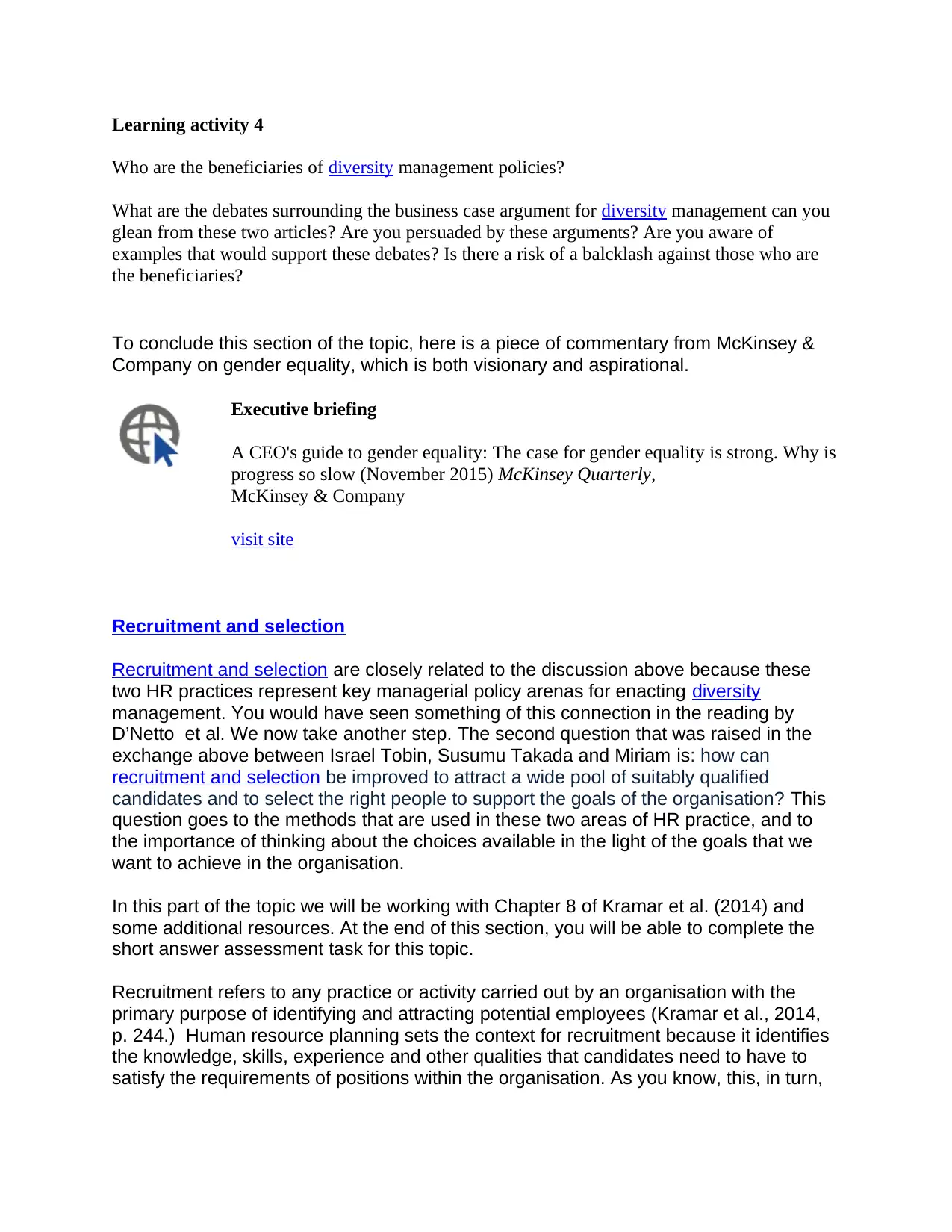
Learning activity 4
Who are the beneficiaries of diversity management policies?
What are the debates surrounding the business case argument for diversity management can you
glean from these two articles? Are you persuaded by these arguments? Are you aware of
examples that would support these debates? Is there a risk of a balcklash against those who are
the beneficiaries?
To conclude this section of the topic, here is a piece of commentary from McKinsey &
Company on gender equality, which is both visionary and aspirational.
Executive briefing
A CEO's guide to gender equality: The case for gender equality is strong. Why is
progress so slow (November 2015) McKinsey Quarterly,
McKinsey & Company
visit site
Recruitment and selection
Recruitment and selection are closely related to the discussion above because these
two HR practices represent key managerial policy arenas for enacting diversity
management. You would have seen something of this connection in the reading by
D’Netto et al. We now take another step. The second question that was raised in the
exchange above between Israel Tobin, Susumu Takada and Miriam is: how can
recruitment and selection be improved to attract a wide pool of suitably qualified
candidates and to select the right people to support the goals of the organisation? This
question goes to the methods that are used in these two areas of HR practice, and to
the importance of thinking about the choices available in the light of the goals that we
want to achieve in the organisation.
In this part of the topic we will be working with Chapter 8 of Kramar et al. (2014) and
some additional resources. At the end of this section, you will be able to complete the
short answer assessment task for this topic.
Recruitment refers to any practice or activity carried out by an organisation with the
primary purpose of identifying and attracting potential employees (Kramar et al., 2014,
p. 244.) Human resource planning sets the context for recruitment because it identifies
the knowledge, skills, experience and other qualities that candidates need to have to
satisfy the requirements of positions within the organisation. As you know, this, in turn,
Who are the beneficiaries of diversity management policies?
What are the debates surrounding the business case argument for diversity management can you
glean from these two articles? Are you persuaded by these arguments? Are you aware of
examples that would support these debates? Is there a risk of a balcklash against those who are
the beneficiaries?
To conclude this section of the topic, here is a piece of commentary from McKinsey &
Company on gender equality, which is both visionary and aspirational.
Executive briefing
A CEO's guide to gender equality: The case for gender equality is strong. Why is
progress so slow (November 2015) McKinsey Quarterly,
McKinsey & Company
visit site
Recruitment and selection
Recruitment and selection are closely related to the discussion above because these
two HR practices represent key managerial policy arenas for enacting diversity
management. You would have seen something of this connection in the reading by
D’Netto et al. We now take another step. The second question that was raised in the
exchange above between Israel Tobin, Susumu Takada and Miriam is: how can
recruitment and selection be improved to attract a wide pool of suitably qualified
candidates and to select the right people to support the goals of the organisation? This
question goes to the methods that are used in these two areas of HR practice, and to
the importance of thinking about the choices available in the light of the goals that we
want to achieve in the organisation.
In this part of the topic we will be working with Chapter 8 of Kramar et al. (2014) and
some additional resources. At the end of this section, you will be able to complete the
short answer assessment task for this topic.
Recruitment refers to any practice or activity carried out by an organisation with the
primary purpose of identifying and attracting potential employees (Kramar et al., 2014,
p. 244.) Human resource planning sets the context for recruitment because it identifies
the knowledge, skills, experience and other qualities that candidates need to have to
satisfy the requirements of positions within the organisation. As you know, this, in turn,
Paraphrase This Document
Need a fresh take? Get an instant paraphrase of this document with our AI Paraphraser
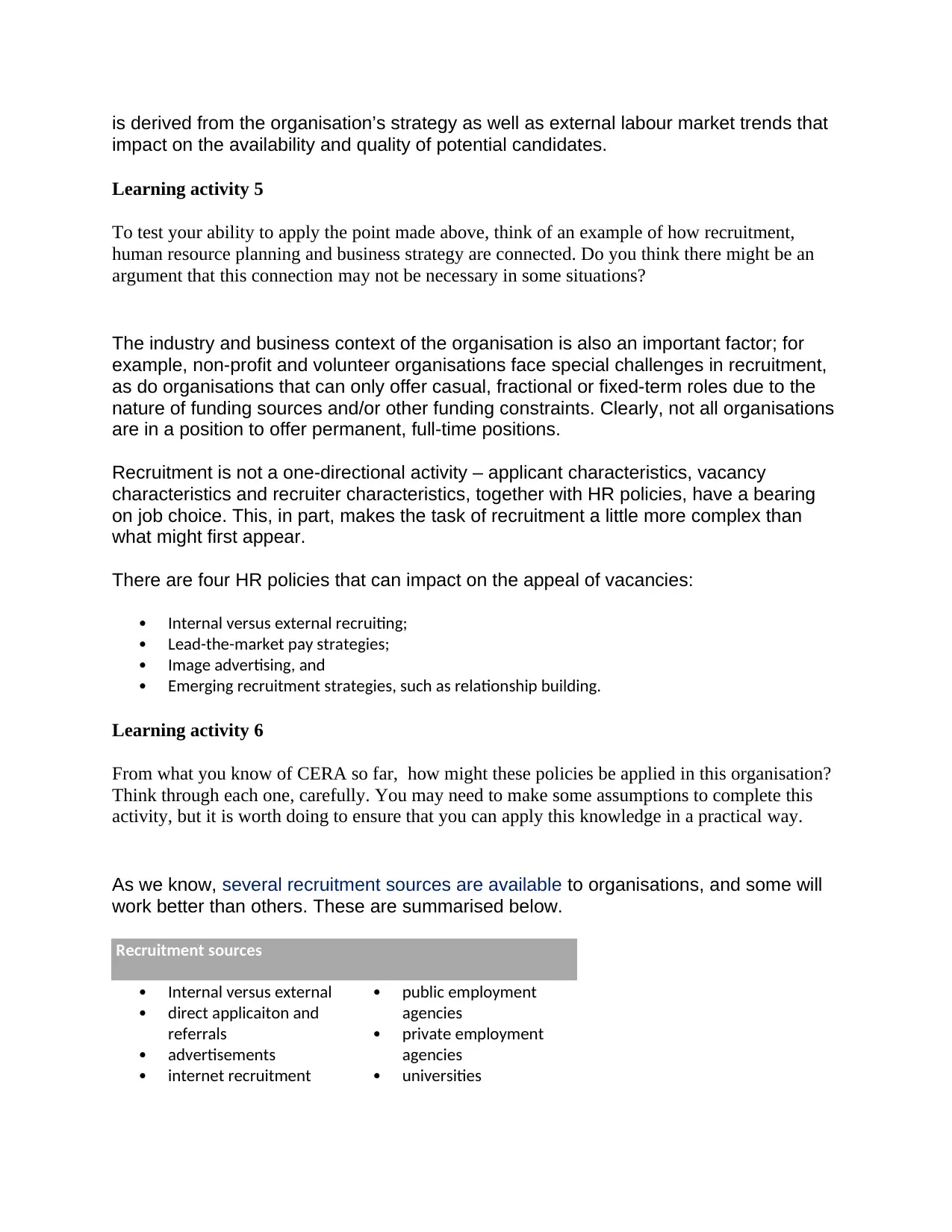
is derived from the organisation’s strategy as well as external labour market trends that
impact on the availability and quality of potential candidates.
Learning activity 5
To test your ability to apply the point made above, think of an example of how recruitment,
human resource planning and business strategy are connected. Do you think there might be an
argument that this connection may not be necessary in some situations?
The industry and business context of the organisation is also an important factor; for
example, non-profit and volunteer organisations face special challenges in recruitment,
as do organisations that can only offer casual, fractional or fixed-term roles due to the
nature of funding sources and/or other funding constraints. Clearly, not all organisations
are in a position to offer permanent, full-time positions.
Recruitment is not a one-directional activity – applicant characteristics, vacancy
characteristics and recruiter characteristics, together with HR policies, have a bearing
on job choice. This, in part, makes the task of recruitment a little more complex than
what might first appear.
There are four HR policies that can impact on the appeal of vacancies:
Internal versus external recruiting;
Lead-the-market pay strategies;
Image advertising, and
Emerging recruitment strategies, such as relationship building.
Learning activity 6
From what you know of CERA so far, how might these policies be applied in this organisation?
Think through each one, carefully. You may need to make some assumptions to complete this
activity, but it is worth doing to ensure that you can apply this knowledge in a practical way.
As we know, several recruitment sources are available to organisations, and some will
work better than others. These are summarised below.
Recruitment sources
Internal versus external
direct applicaiton and
referrals
advertisements
internet recruitment
public employment
agencies
private employment
agencies
universities
impact on the availability and quality of potential candidates.
Learning activity 5
To test your ability to apply the point made above, think of an example of how recruitment,
human resource planning and business strategy are connected. Do you think there might be an
argument that this connection may not be necessary in some situations?
The industry and business context of the organisation is also an important factor; for
example, non-profit and volunteer organisations face special challenges in recruitment,
as do organisations that can only offer casual, fractional or fixed-term roles due to the
nature of funding sources and/or other funding constraints. Clearly, not all organisations
are in a position to offer permanent, full-time positions.
Recruitment is not a one-directional activity – applicant characteristics, vacancy
characteristics and recruiter characteristics, together with HR policies, have a bearing
on job choice. This, in part, makes the task of recruitment a little more complex than
what might first appear.
There are four HR policies that can impact on the appeal of vacancies:
Internal versus external recruiting;
Lead-the-market pay strategies;
Image advertising, and
Emerging recruitment strategies, such as relationship building.
Learning activity 6
From what you know of CERA so far, how might these policies be applied in this organisation?
Think through each one, carefully. You may need to make some assumptions to complete this
activity, but it is worth doing to ensure that you can apply this knowledge in a practical way.
As we know, several recruitment sources are available to organisations, and some will
work better than others. These are summarised below.
Recruitment sources
Internal versus external
direct applicaiton and
referrals
advertisements
internet recruitment
public employment
agencies
private employment
agencies
universities
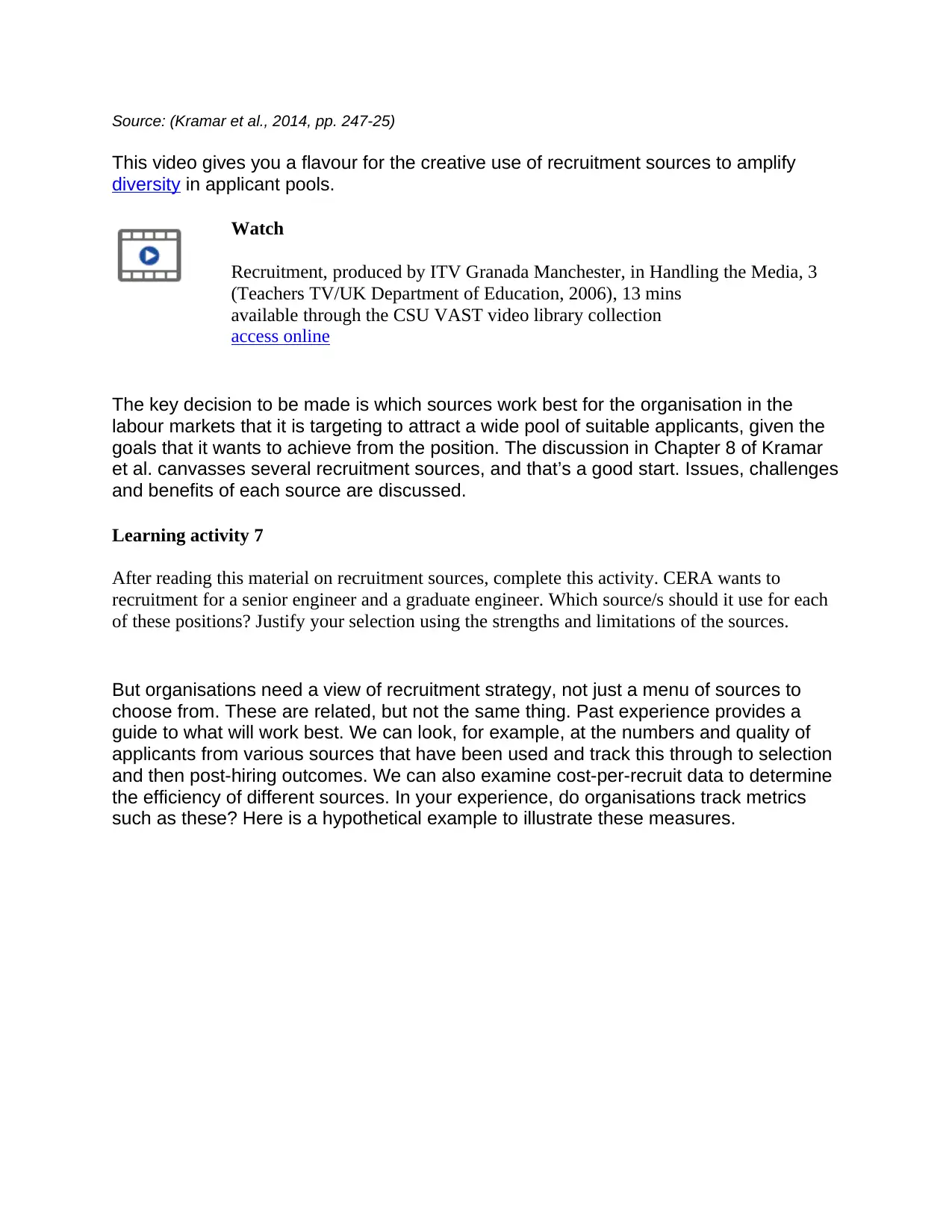
Source: (Kramar et al., 2014, pp. 247-25)
This video gives you a flavour for the creative use of recruitment sources to amplify
diversity in applicant pools.
Watch
Recruitment, produced by ITV Granada Manchester, in Handling the Media, 3
(Teachers TV/UK Department of Education, 2006), 13 mins
available through the CSU VAST video library collection
access online
The key decision to be made is which sources work best for the organisation in the
labour markets that it is targeting to attract a wide pool of suitable applicants, given the
goals that it wants to achieve from the position. The discussion in Chapter 8 of Kramar
et al. canvasses several recruitment sources, and that’s a good start. Issues, challenges
and benefits of each source are discussed.
Learning activity 7
After reading this material on recruitment sources, complete this activity. CERA wants to
recruitment for a senior engineer and a graduate engineer. Which source/s should it use for each
of these positions? Justify your selection using the strengths and limitations of the sources.
But organisations need a view of recruitment strategy, not just a menu of sources to
choose from. These are related, but not the same thing. Past experience provides a
guide to what will work best. We can look, for example, at the numbers and quality of
applicants from various sources that have been used and track this through to selection
and then post-hiring outcomes. We can also examine cost-per-recruit data to determine
the efficiency of different sources. In your experience, do organisations track metrics
such as these? Here is a hypothetical example to illustrate these measures.
This video gives you a flavour for the creative use of recruitment sources to amplify
diversity in applicant pools.
Watch
Recruitment, produced by ITV Granada Manchester, in Handling the Media, 3
(Teachers TV/UK Department of Education, 2006), 13 mins
available through the CSU VAST video library collection
access online
The key decision to be made is which sources work best for the organisation in the
labour markets that it is targeting to attract a wide pool of suitable applicants, given the
goals that it wants to achieve from the position. The discussion in Chapter 8 of Kramar
et al. canvasses several recruitment sources, and that’s a good start. Issues, challenges
and benefits of each source are discussed.
Learning activity 7
After reading this material on recruitment sources, complete this activity. CERA wants to
recruitment for a senior engineer and a graduate engineer. Which source/s should it use for each
of these positions? Justify your selection using the strengths and limitations of the sources.
But organisations need a view of recruitment strategy, not just a menu of sources to
choose from. These are related, but not the same thing. Past experience provides a
guide to what will work best. We can look, for example, at the numbers and quality of
applicants from various sources that have been used and track this through to selection
and then post-hiring outcomes. We can also examine cost-per-recruit data to determine
the efficiency of different sources. In your experience, do organisations track metrics
such as these? Here is a hypothetical example to illustrate these measures.
⊘ This is a preview!⊘
Do you want full access?
Subscribe today to unlock all pages.

Trusted by 1+ million students worldwide
1 out of 32
Related Documents
Your All-in-One AI-Powered Toolkit for Academic Success.
+13062052269
info@desklib.com
Available 24*7 on WhatsApp / Email
![[object Object]](/_next/static/media/star-bottom.7253800d.svg)
Unlock your academic potential
Copyright © 2020–2025 A2Z Services. All Rights Reserved. Developed and managed by ZUCOL.




